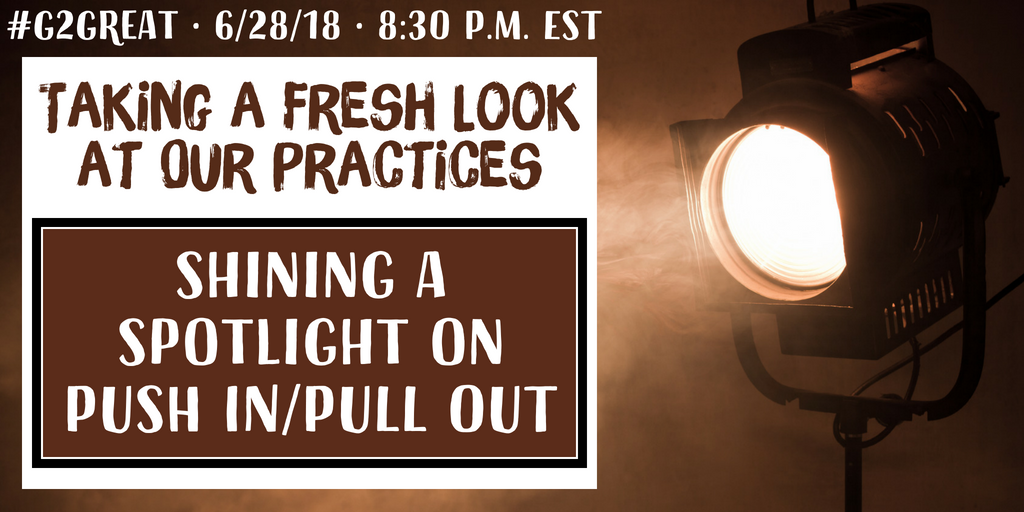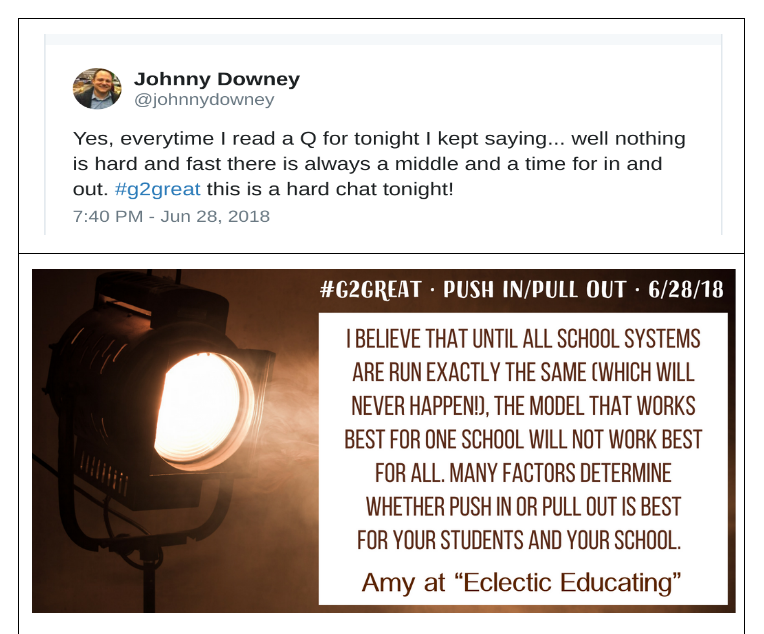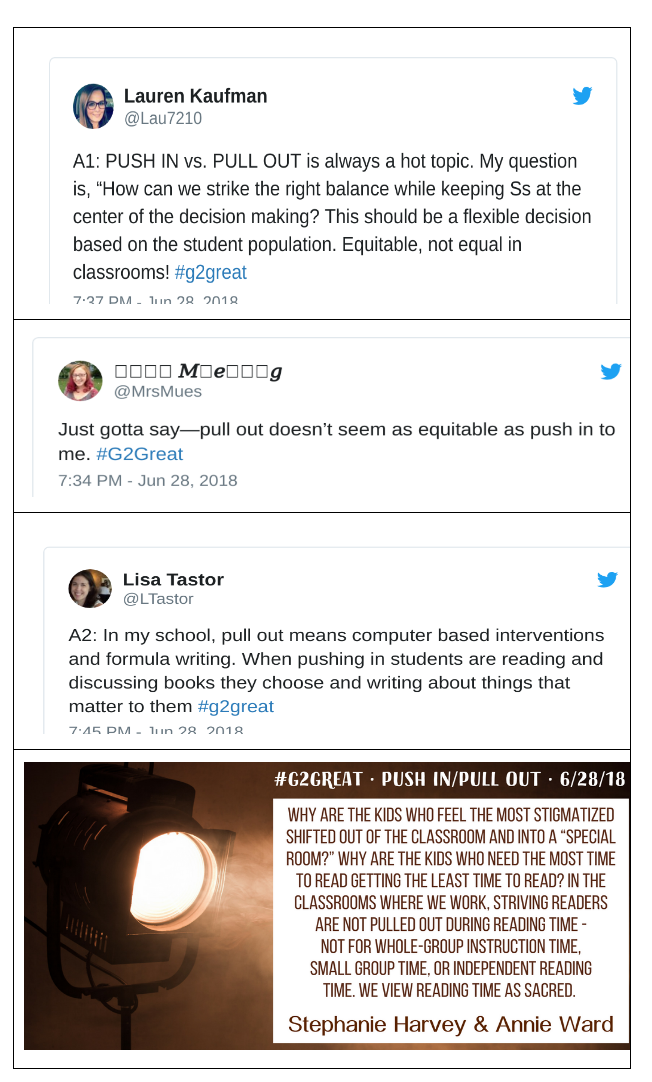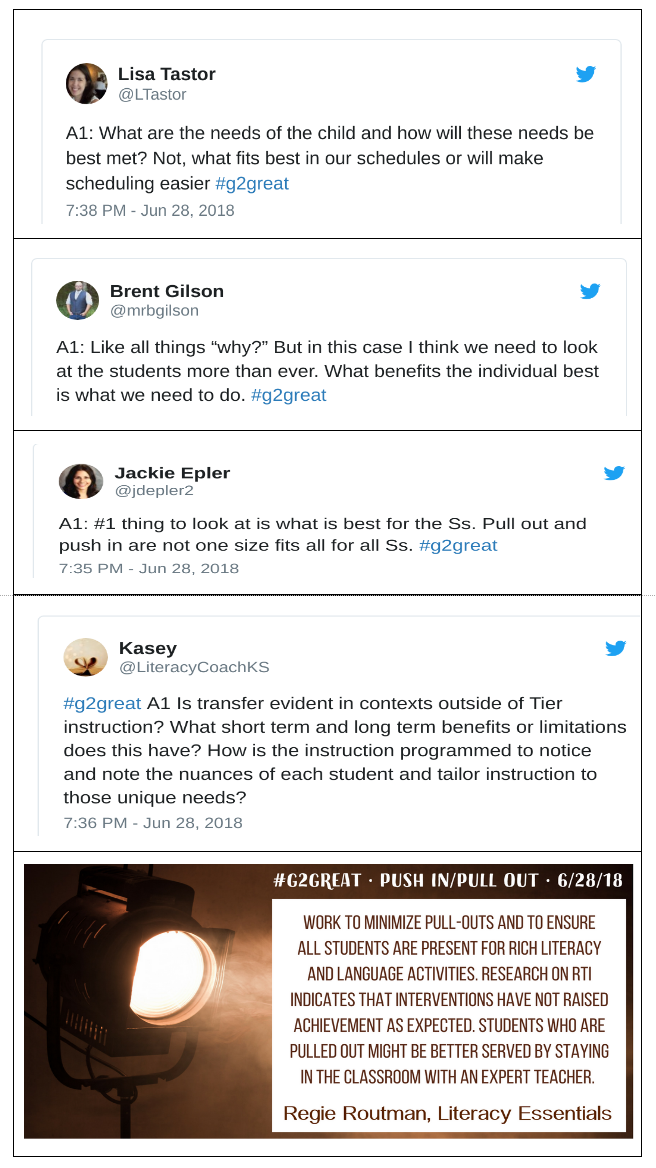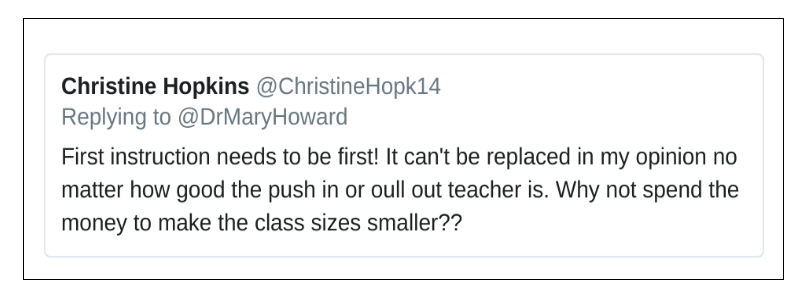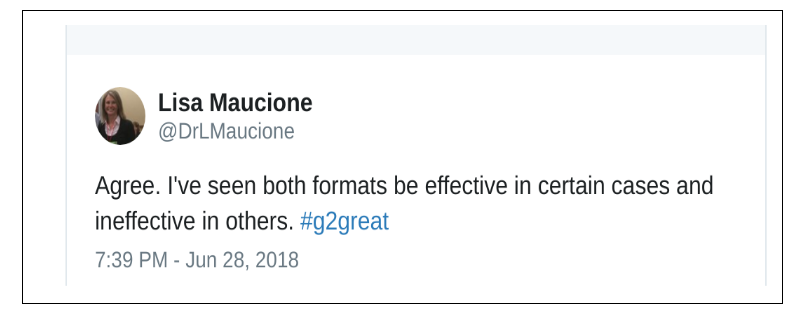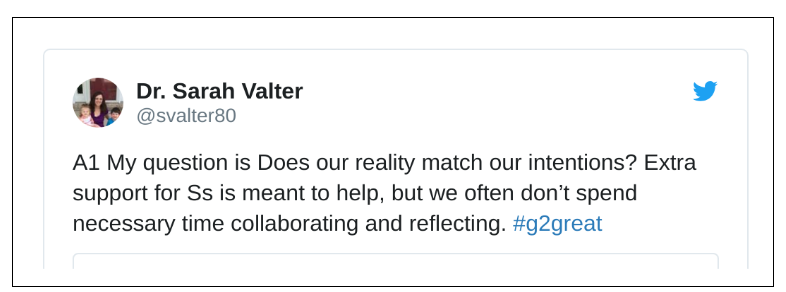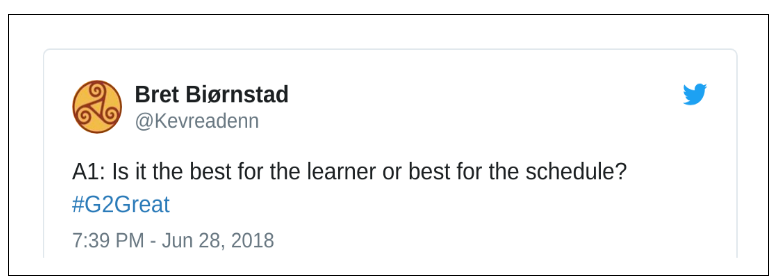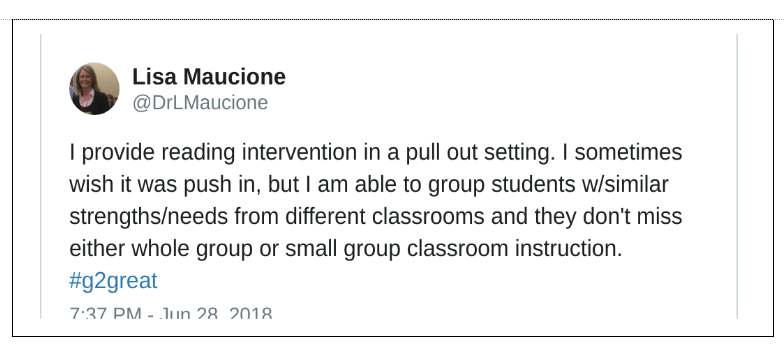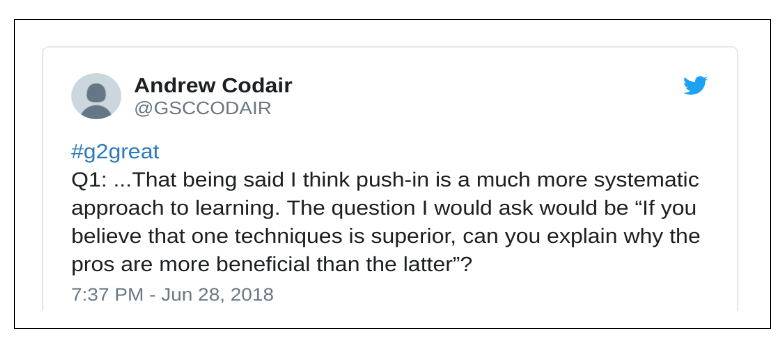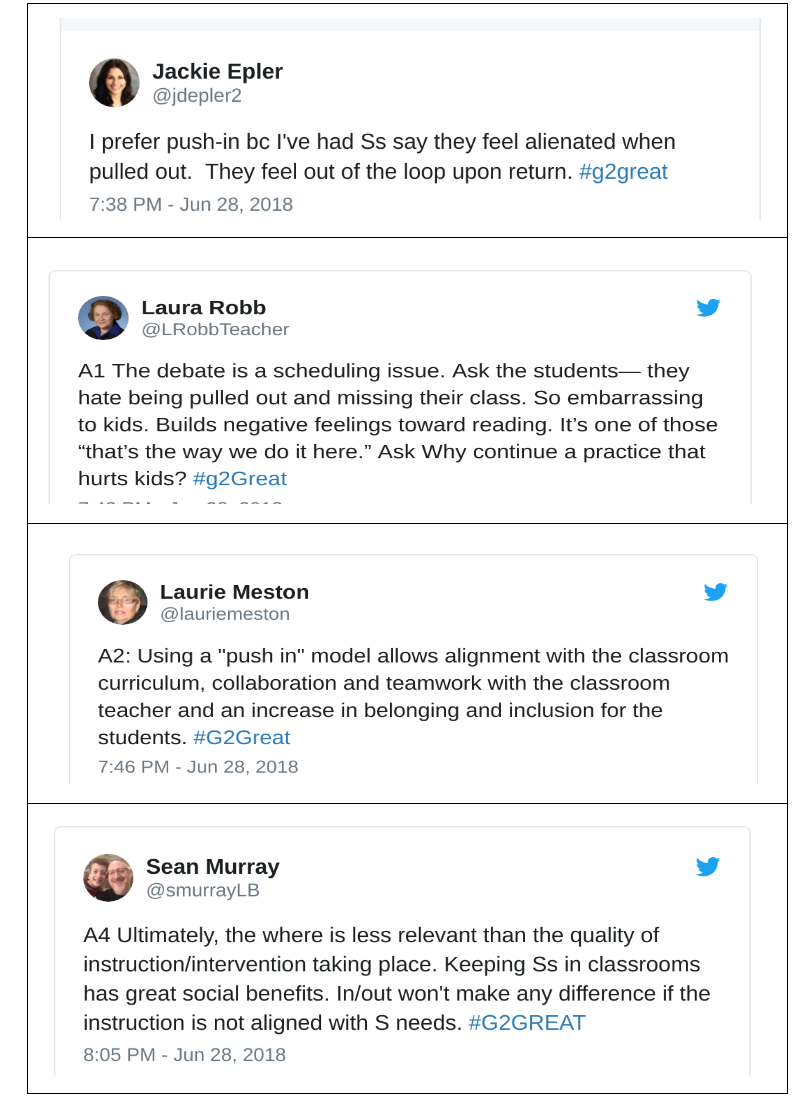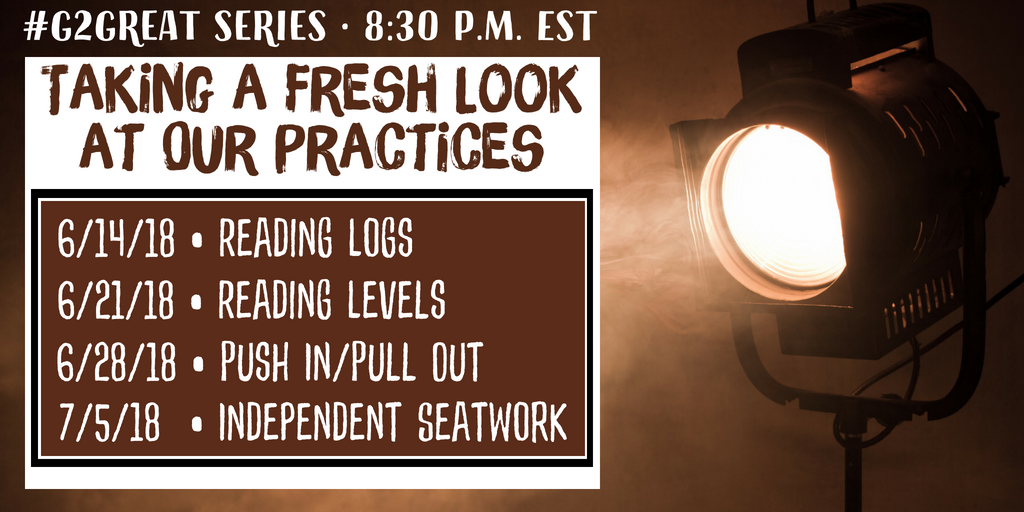by Mary Howard
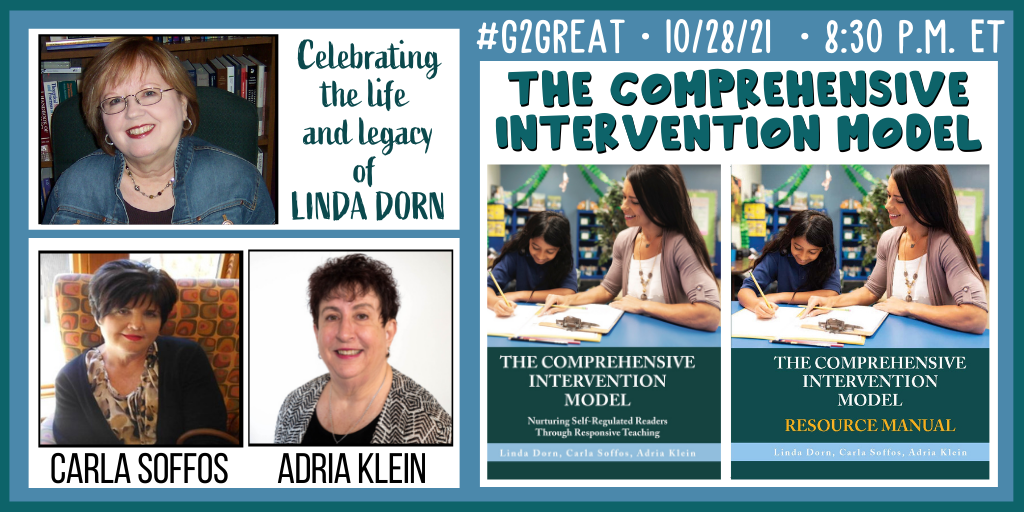
On 10/28/21, #G2Great engaged in a long-awaited celebration that was years in the making when we soaked in a literacy gift from authors Linda Dorn, Carla Soffos and Adria Klein: The Comprehensive Intervention Model: Nurturing Self-Regulated Readers Through Responsive Teaching (2021, Stenhouse). The CIM has enriched the lives of students and teachers in countless schools and districts and now the combined CIM wisdom of the authors is available to us all.
My appreciation for CIM began with a book that I’ve referenced many times over the years: Interventions that Work: A Comprehensive Intervention Model for Preventing Reading Failure in Grades K-3 by Linda Dorn and Carla Soffos (2011, Pearson). In the preface, Adria Klein describes this 2021 book as a “completely revamped and expanded” follow up to its predecessor (page xiii). Having read both books, ‘revamped and expanded’ feels like an understatement since the pairing of the CIM book and Resource Manual offer in-depth detail enriched by forms, charts, examples and over fifty videos quickly accessed by QR Codes.
These dramatic revamped and extended additions deepen our understandings. Interventions that Work focused on grades K-3 but that reach is extended to the upper grades detailed in Chapter 8: Comprehension Focus Groups for Increasing Comprehension Power (pages 127-123). Chapter 9 is another important addition with Strategic Processing Intervention for Students with Reading Disabilities (pages 144-157). These new chapters along with refined descriptions of the layers of interventions, the Language Phase embedded across layers and added research on the transfer of learning will magnify the CIM implementation process.
With these gifts in mind, I suddenly find myself thinking back to the rocky Response to Intervention (RTI) journey launched by IDEA 2004. I have been quite vocal about the many missteps of RTI, which I detailed RTI from All Sides: What Every Teacher Needs to Know (2009, Heinemann). This meandering RTI path is riddled with the deluded premise that we can buy our way to success through programs disseminated and mandated across a school or district. Add to this stunning fallacy the disconnect between interventions and instruction and the flawed data collection systems leading to flawed decision making, it shouldn’t be a surprise that our children have become the RTI sacrificial lambs.
Unfortunately, the most critical components of the intervention process have been glaringly absent in traditional RTI approaches, thus contributing to one failed effort after another. After seventeen years of missteps, we have been afforded an opportunity to leave those failures behind us and change the very face of RTI moving forward. The CIM book and Resource Manual combined will show us how to accomplish that if we are willing to read this book pairing and heed the wise advice of Linda Dorn, Carla Soffos and Adria Klein.
When Carla and Adria asked me to write an endorsement for The CIM, I was honored. From the first time I had learned about CIM, I was certain that it was the much-needed shift in thinking we needed to alter our RTI course. In my endorsement on the Stenhouse website I wrote:
“The Comprehensive Intervention Model renews my hope for the future of educators who are wise enough to put the authors’ sage advice into glorious schoolwide action in honor of children.” Mary Howard, 2021
The HOPE I refer to is lovingly woven across each page of the CIM reference duo. Linda, Carla and Adria help us to re-envision the intervention and instructional process in a way that will later our RTI success trajectory. Since I can’t do justice to the brilliance flowing generously across CIM, I’ll condense this post to four central features of CIM that “renew my hope” in very profound ways along with a quote from the authors that highlight each feature. As you read, note that each of these four features are needed in combination as they work in support of and in coordination each other.
ONGOING PROFESSIONAL LEARNING
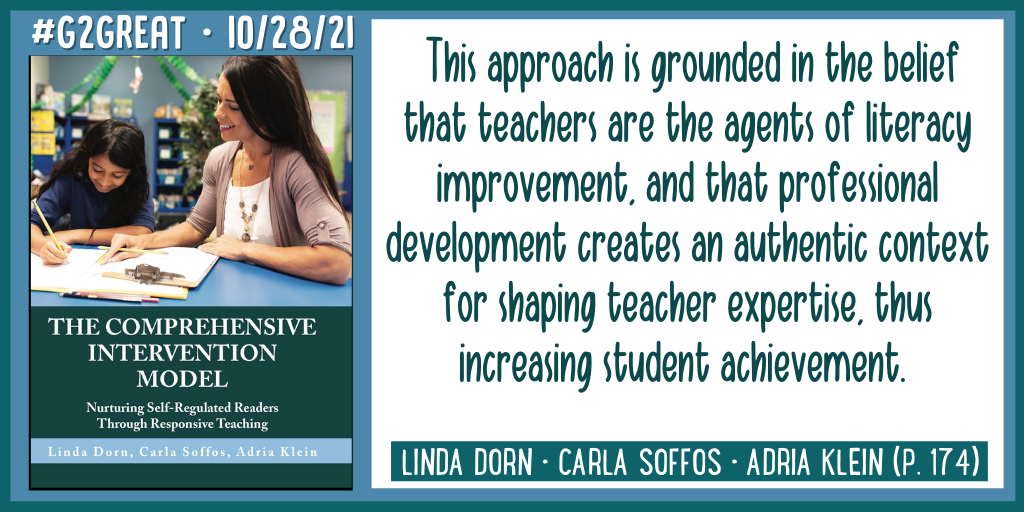
As soon as my copy of the CIM arrived, I took the authors advice to begin with Chapter 10: Implementing the Comprehensive Model for Literacy Improvement (pages 158-175). This chapter opens with the Ten Principles of CIM Professional Development Design followed by examples of districts that have applied these principles. The very heart and soul of CIM is reflected in the quote above. There are no programs to buy. There are no quick fix solutions to be forced into action. There are no scripts to follow. There are no data fueled devices that blind us to the needs of children. In every word, the authors demonstrate deep respect for teachers and the important role that knowledgeable educators play as “agents of literacy improvement” who are given the instructional support and coaching over time that is at the center of our efforts.
COLLECTIVE COLLABORATION AND COORDINATION
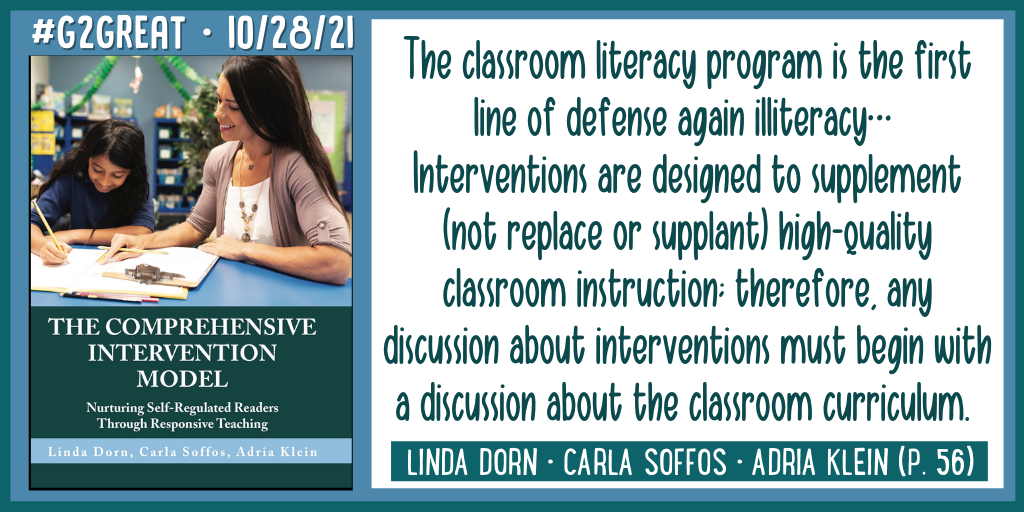
One of the biggest missteps of the RTI process to date has been a pervasive view of interventions the as support offered beyond the general education setting. The quote above acknowledges that any effective RTI design is grounded in the idea that the classroom teacher is at the forefront of our efforts. The authors emphasize that if an intervention is deemed necessary, it is always seen as “in addition to” rather than “instead of” support. The classroom teacher is the first line of defense so intervention always occur within a spirit of collaboration and coordination. This requires collective responsibility as illustrated by the CIM as a systemic approach to RTI designed to create an intervention and instructional culture from a schoolwide and districtwide level. Without this, we rob children of important learning opportunities by using interventions as a substitute of daily instruction rather than using them to supplement instruction.
MULTI-TIERED SYSTEM OF SUPPORT
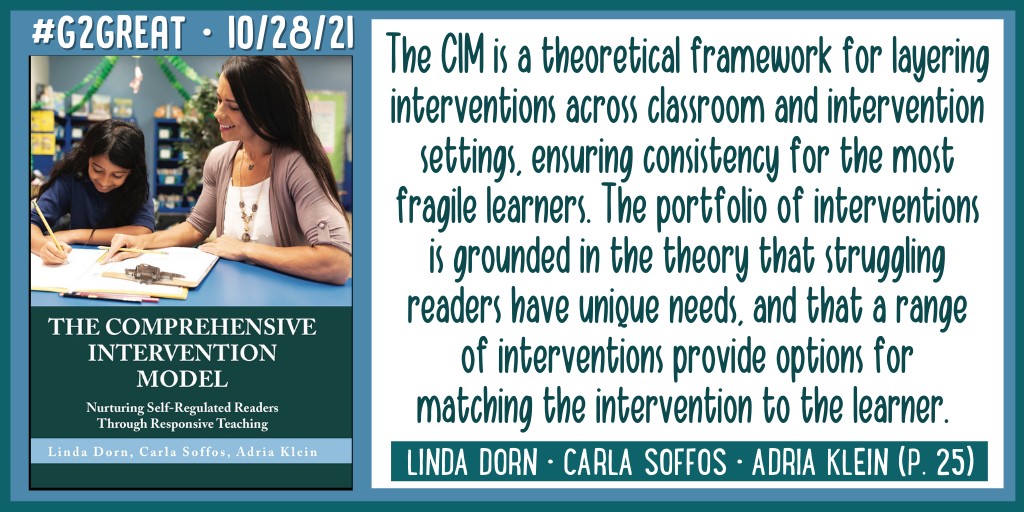
On page 170 in Figure 10.5 shown below is the most effective intervention design framework that I have ever seen in any RTI Model to date.
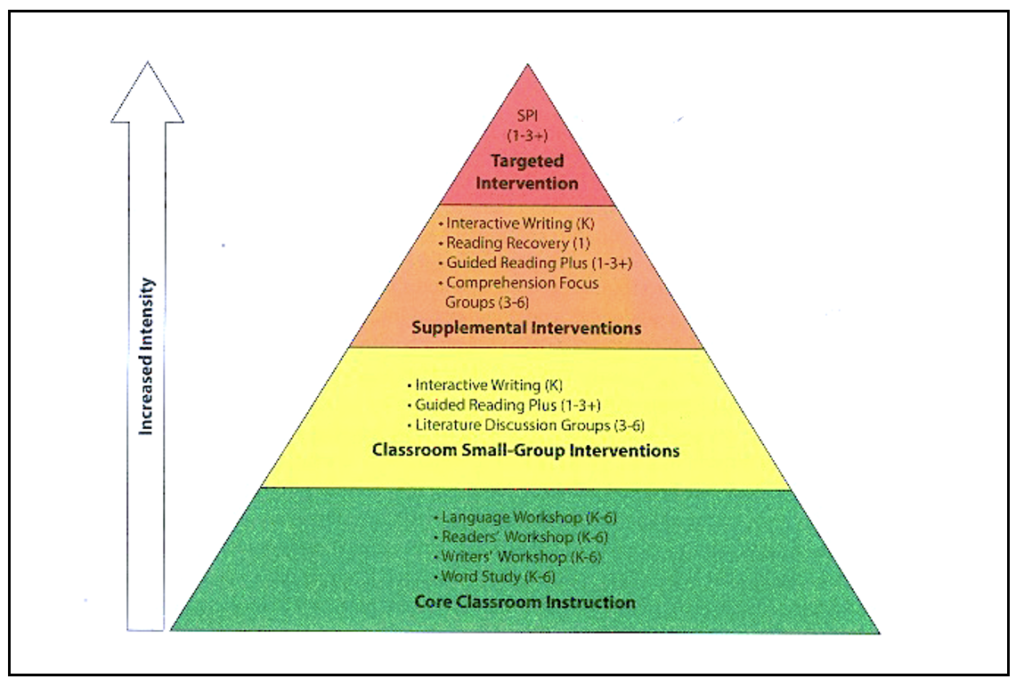
The authors write “A decision-making model with layers of instructional support and degrees of intensity provides a framework for meeting the unique needs of students with reading problems.” This four-section triangle may look like other RTI models at first glance, but it is distinct in design and intent. The layers are shown as least to most intensive from the bottom up. The least intensive is Core Classroom Instruction provided by the classroom teacher with most intensive Targeted Interventions at the top where SPI specialist Strategic Processing Interventions are provided by a SPI specialist. Two layers in the center provided by CIM Specialists inxlusw tier 2 with Classroom Small Group Interventions followed by tier 3 with Supplemental Interventions. These draw from the “portfolio” of intervention options described in chapters 5 through 9. This extended design highlights collective responsibility where collaboration and coordination are central to our efforts.
EVIDENCE-BASED DECISION MAKING

Educators have long experienced the ebb and flow of ever-present obsession with standardized test scores and numerical data linked to suspect programs. The CIM refocuses our attention to the child by emphasizing that multiple assessments with careful analysis help us uncover “evidence of the student’s knowledge, thinking and problem-solving” as we discover the patterns that begins to merge across assessments. This positions assessment as a thread that connects instruction and interventions within the context of active engagement in learning. With the support of learner-centered data that includes thoughtful kidwatching, we draw from varied informants that can lead to evidence-based decision-making on behalf of the children in front of us rather than what is too often purported to exist beneath a color coded spreadsheets. Combined with the joining of professional minds in ways that supports our shared understandings from unique perspectives, we have a responsive teaching design at its finest.
TWITTER STYLE GLIMPSE OF CIM FROM THE AUTHORS’ WISE EYES
During the #G2Great chat, Adria and Carla merged their reflections on our eight chat questions. I have spotlighted this incredible shared thinking below.
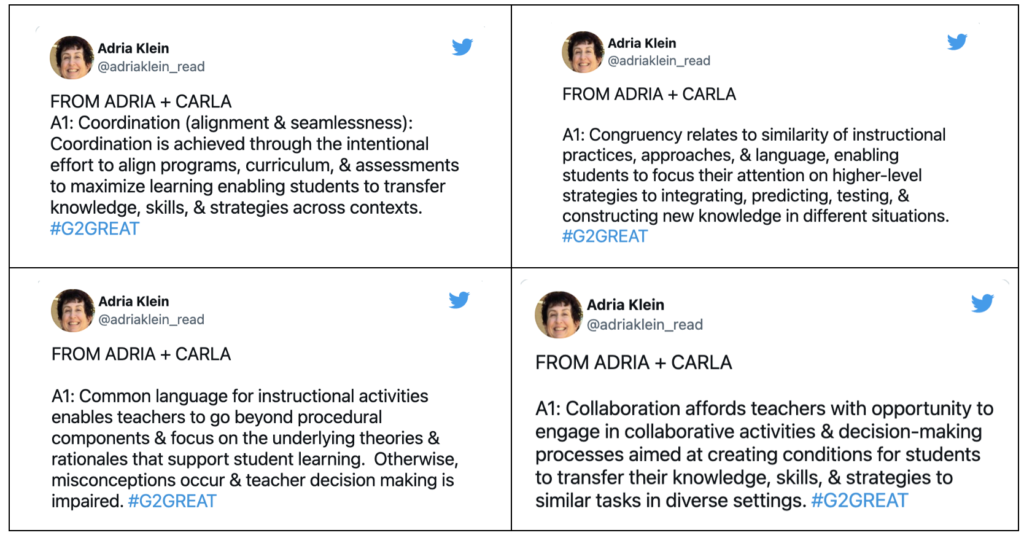
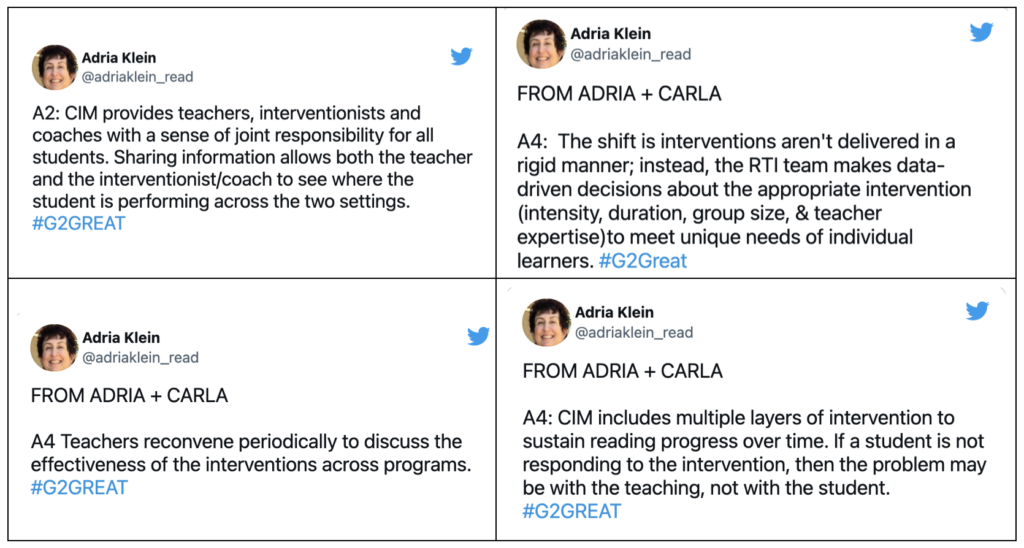

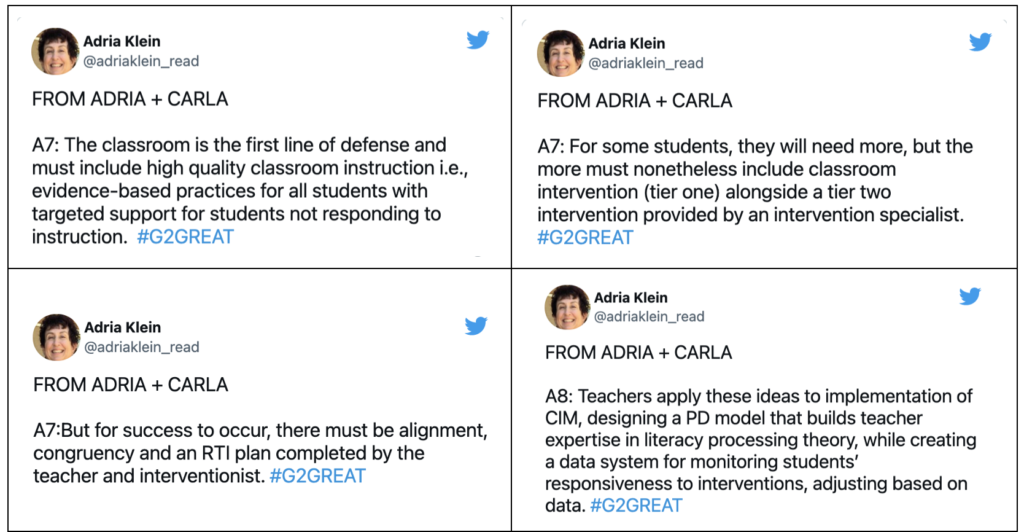
MY CLOSING THOUGHTS
As I come to the close of this post, I am once again inspired by authors Linda Dorn, Carla Soffos and Adria Klein. What they have accomplished in this paired resource will change the way that we think about the RTI process. No detail is seen as too small and every possible support that schools could need to initiate the CIM has been included across the book with other learning opportunities available to teachers beyond those resources.

Filled with gratitude , I pause to reach for this exquisite professional gift and my thoughts turn to Linda Dorn. I am fortunate to be one of many educators who has been inspired and informed by Linda Dorn. Lost in this moment of appreciation, I suddenly recalled an email correspondence from Linda dated December 23, 2010. I had been sharing the CIM widely, but after teachers had expressed concern about the requirements I wrote Linda for clarification. She quickly responded, explaining that teachers can implement CIM at two levels. While the first level does require specific training, Linda added:
However, because we realize that most teachers are unable to access the university training, we want to ensure that anyone who wants to implement the CIM has this opportunity. In these cases, we encourage schools to use the professional texts and DVDs as resources for implementing their RtI process. Some schools may have RR; others will not. And if teachers are interested, they can attend professional development summer institutes on the CIM in different parts of the country, including the CIM university training centers.
Linda’s response reflects how much she believed in giving teachers access to the principles and support that I am now holding in my hands (those “DVDs” Linda mentioned are now accessed directly in the book). The first level of extended training is certainly preferable, but Linda’s words ensure that CIM is within reach of every teacher inspired to make this important shift. That’s not surprising given Linda’s contribution highlighted in a Stenhouse tribute:
“Linda was the primary developer and lead trainer of the Partnerships in Comprehensive Literacy Model, a nationally recognized model that uses literacy coaches as agents of change… She believed that school-embedded professional development is critical for supporting teachers in new learning.”
Those words come alive in the CIM book and resource manual. Linda Dorn’s dedication to CIM and the teachers and students who would benefit from it was so strong that she continued to work on this book while she was battling cancer. Following her death on 9/17/19, co-authors and dear friends Carla Soffos and Adria Klein stepped up and worked tirelessly to ensure that this book would one day be in the hands of educators everywhere. That long-awaited day has come.
As I type these words with the CIM perched lovingly within reach, I think about the many books written by Linda Dorn that are my frequent companions on my bookshelf. What better way to honor Linda’s legacy and the principles that guided her professional life than to put those principles into glorious schoolwide action in honor of children. This exquisite book will show us how to bring Linda’s legacy to life in classrooms everywhere.
With deep gratitude to Linda Dorn, Carla Soffos, and Adria Klein for making this possible
